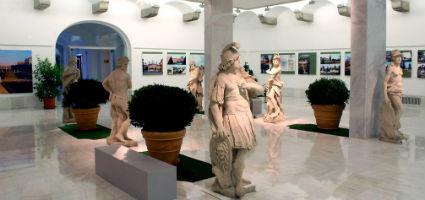2024. May 8. Wednesday
National Office of Cultural Heritage - Heritage Gallery - Budapest
 |
Address: 1014, Budapest Táncsics Mihály utca 1.
Phone number: (1) 225-4800
E-mail: koh@koh.hu
Opening hours: Mon-Sat 9-17
|
The exhibition has closed for visitors.
2008.02.15. - 2008.03.30.
It was about 20 years ago when industrial buildings were listed among scheduled buildings. This process fastened after the "change of regime" when during "privatization" Hungarian industry got significantly damaged when many of the mines and plants were closed for good. The values related to these industrial buildings could be saved by revitalization methods for which we can find rare examples in Hungary too. However, there is a lot to do in the "rust belts" too.
This is why we believe that the drawing series picturing European industrial towns by the graphic artist Rudolf Schönwald is worth showing. Issues have been raised by photo exhibitions (eg. the exhibitions of Róbert Hack or József Hajdú) but we rarely meet anything similar when encountering art graphics. Schönwald is an apt follower of artists of the 19 century. The seemingly unmoved fixing of state is the only part of the drawings. Via framing, composition, highlighting and ellipsis the visitors can see quality artworks.
(...) A giant factory or mine are organisms for the artist as they have a lifespan and a life of their own. We consider them similarly to the PULVIS ET UMBRA SUMUS - "We are dust and shadow", as Horatius put it once: In old Hungarian: "Isa pur és homu vogymuk", just as in his drawing series on human and animal skeleton. The skill and ideal of artworks picturing decaying industry is recalled by a series shown at the Galerie Ulysses in Vienna in 1996. The series pictures the lecture room of the "Anatomy Theatre" of the University of Leiden with skeletons in the upper rows of seats.
Theatre has always interested him, just as this ultimate theatre. At the Cellar Gallery we show a few of the heroes Jarry and King Übü he is immensely interested in. These are graphics by an artist who experienced the kingdom of Übü in flesh, in Hungary too. This artist returned to the scene of his youth, the scene of emotions and thought that require the same from us.
András Hadik (arts historian, Hungarian Museum of Architecture)
This is why we believe that the drawing series picturing European industrial towns by the graphic artist Rudolf Schönwald is worth showing. Issues have been raised by photo exhibitions (eg. the exhibitions of Róbert Hack or József Hajdú) but we rarely meet anything similar when encountering art graphics. Schönwald is an apt follower of artists of the 19 century. The seemingly unmoved fixing of state is the only part of the drawings. Via framing, composition, highlighting and ellipsis the visitors can see quality artworks.
(...) A giant factory or mine are organisms for the artist as they have a lifespan and a life of their own. We consider them similarly to the PULVIS ET UMBRA SUMUS - "We are dust and shadow", as Horatius put it once: In old Hungarian: "Isa pur és homu vogymuk", just as in his drawing series on human and animal skeleton. The skill and ideal of artworks picturing decaying industry is recalled by a series shown at the Galerie Ulysses in Vienna in 1996. The series pictures the lecture room of the "Anatomy Theatre" of the University of Leiden with skeletons in the upper rows of seats.
Theatre has always interested him, just as this ultimate theatre. At the Cellar Gallery we show a few of the heroes Jarry and King Übü he is immensely interested in. These are graphics by an artist who experienced the kingdom of Übü in flesh, in Hungary too. This artist returned to the scene of his youth, the scene of emotions and thought that require the same from us.
András Hadik (arts historian, Hungarian Museum of Architecture)